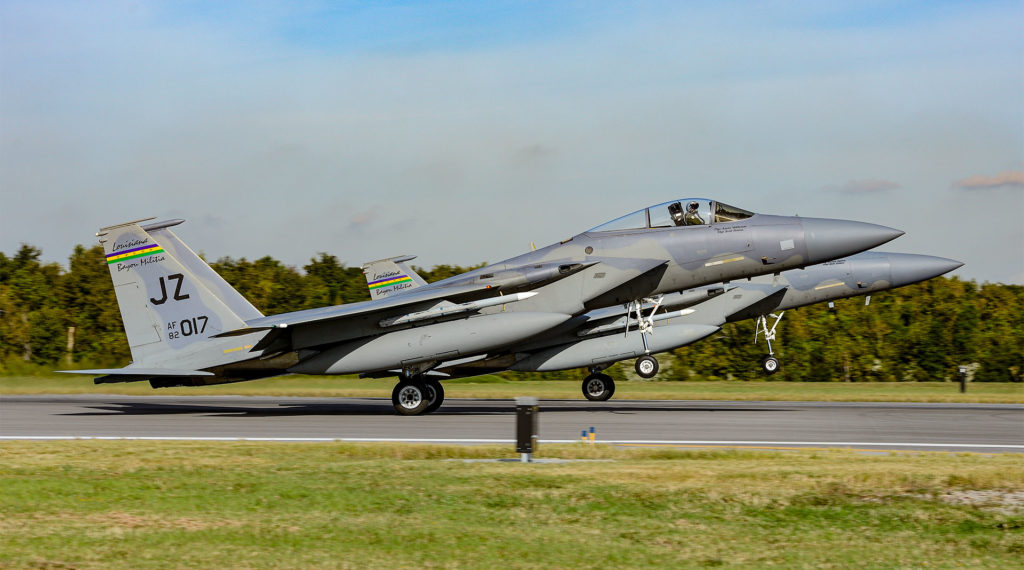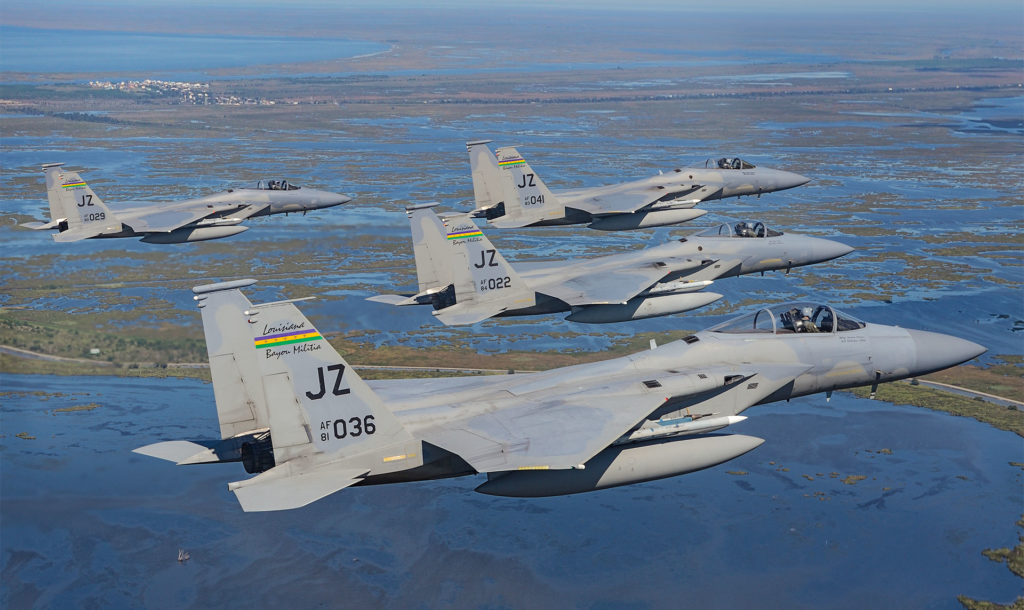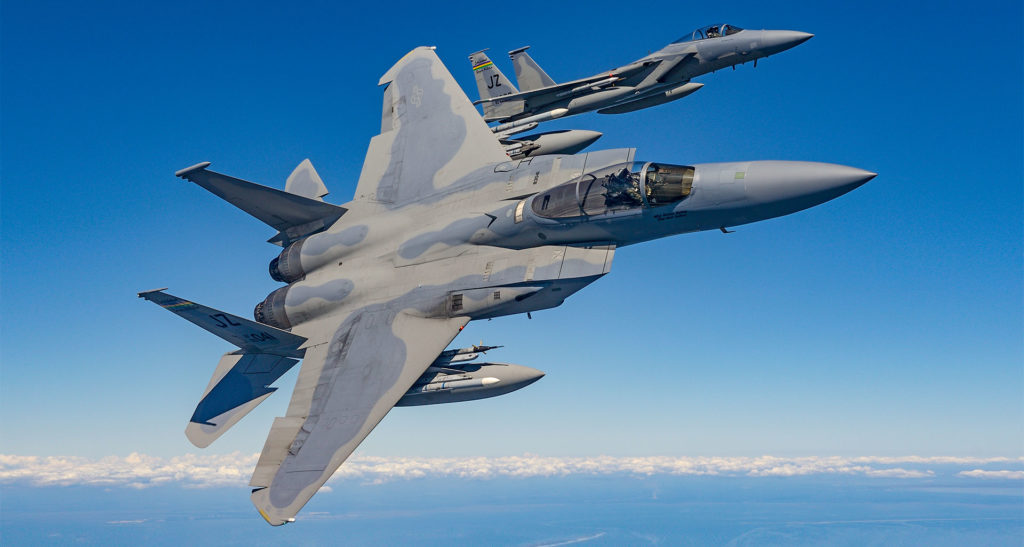Estimated reading time 13 minutes, 50 seconds.
“It’s just a case of being in the right place at the right time,” LCol Sam Joplin told Skies in a humble response to the question of how he was selected as the commanding officer of the 122nd Fighter Squadron. Better known by his callsign, “Nuke,” Joplin is a U.S. Air Force F-15C Eagle pilot who has flown the world’s most famous air superiority fighter since 2004. However, landing his current position was due to far more than a simple case of timing. Taking the reins of the squadron known as the “Bayou Militia” in October 2019 marked the pinnacle of a career at the cutting edge of combat air power.
The 122nd Fighter Squadron comes under the 159th Fighter Wing, Louisiana Air National Guard (ANG). The unit is based at Naval Air Station Joint Reserve Base New Orleans, just south of the city known as the “Big Easy,” and is one of six Eagle squadrons in the Guard. Joplin assumed command from his close friend, LCol Ben “Evil” Cook, having spent two years serving under him as the unit’s director of operations — known as DO.

“I took over from ‘Evil’ right after we returned from our summer Theater Security Package to Guam,” explained Joplin, while conceding that possessing all the right credentials to be an F-15 squadron commander is no easy task.
“I was in the active-duty U.S. Air Force for 14-and-a-half years; [I] flew the F-15C at Eglin Air Force Base and at Kadena in Japan before I left in August 2013 to join the Air National Guard, and came here to join the 122nd Fighter Squadron,” Joplin revealed. “There are some big differences between the active duty and the Guard, and striking a balance is really important. This squadron is comprised of a lot of ‘Guard babies,’ as we call them, who joined the ANG from the outset and that’s their primary career. Plus, we have those who have prior service, like me, who then moved across to the Guard.”

Guard Life
Like all ANG units, the Bayou Militia has a mixture of full-timers and traditional guardsmen — those who have a primary job and fit their military life in around that main commitment, commonly known as “weekend warriors.”
“The full-timers are meant to be there to maintain proficiency, to run the squadron, and to train the part-timers when they are there — but it’s not quite that cut and dry,” said Joplin. “The part-timers have the same say, but they do it in different bits and pieces. It’s really the mid-level captains that truly run the engine room of the squadron.”
The state military plans for Guard units to “drill” one weekend each month; the broad intent is for the part-timers to attend drill weekends to maintain their proficiency items and training. Then they go back to their primary jobs.
“For a fighter squadron, it’s not that easy because you can’t get everything you need done in just two days,” Joplin explained. “We counted up something like 175 separate currency items needed for a pilot in a Guard F-15 squadron, ranging from knowing how the fire extinguishers in the squadron work, up to our tactical flying currencies in the Eagle! The list goes on and on. So, for a fighter squadron we are sort of a quasi-active duty and classic Guard. Our part-timers come in frequently, not just on drill weekends. They may come for a week, fly for three or four days, because what is required here is way above what is required of a traditional guardsman that does another job.”

Many of Joplin’s aviators at the squadron are airline pilots, who fit in the rigors of maintaining their myriad of qualifications in the Eagle with their time in the cockpit of an Airbus or a Boeing. Joplin has been a first officer on the Boeing 777 with FedEx since 2016. However, he is on a leave of absence to be able to fulfill his role as squadron commander. He will begin his return to the cockpit of a widebody airliner this summer.
Joplin acknowledged that the typical routine of up to two weeks per month flying an airliner for the part-timers leaves plenty of scope to stay sharp in the F-15.
“It’s two totally different disciplines,” he said, comparing those two sides of aviation. “General air sense and experience count for both, but when you get into the nuts and bolts there’s very little similarity. In the Eagle, we joke about the admin part of a mission — we call it ‘motherhood’ — and that’s essentially getting out to and back from our operating airspace. That includes taking off, flying departure procedures, the comms with air traffic, getting airspace clearance, then coming back to the field — you have to be able to do that. . . . You learn it in pilot training and get good at it — it’s a lifelong skill.
“In the airline world, it’s all motherhood: the procedures, running the flight management system — it’s a totally different realm of flying. In the Eagle — and any other fighter, for that matter — it’s about what you do in the airspace. You make your money out there doing the tactical stuff.”
So, is it challenging to manage the myriad of currencies when everyone is on a different work schedule? No doubt. But it’s certainly possible.
“Flying a fighter is changing tactically like never before, and it’s really down to the individual to stay on top of it all,” said Joplin. “On any given day you will have all the full-timers, plus two or three part-time pilots working on their currencies, mission planning, additional duties — they sort of manage their own schedule. They work with the flight commanders to let them know how many sorties they need to stay current. We have a training department, as well as chief and part-time schedulers. So, the overall workload is spread around.”

Core Missions
The roughly 30 pilots in the Bayou Militia are generally extremely experienced, having a long career flying in the military. This sets the team in good stead to meet the core needs of the fighter squadron — at the center of which lies the Homeland Defense mission.
“We joke that the alert mission is what keeps the lights on around here,” Joplin laughed. “We are a key component of the Homeland air defense infrastructure. We train and measure ourselves against that role and of being a combat-coded F-15 squadron — providing air superiority is our banner mission. If you are a proficient F-15 pilot that can fly offensive and defensive counter air, that’s what we’re looking for.”
Pilots here typically sit alert three or four days per month; this can be any day of the week, any time of day, poised and ready to scramble in F-15s armed with live missiles. “We operate like an active-duty squadron — our training and mission is the same.”

Indeed, the 122nd Fighter Squadron has active-duty personnel assigned as part of the Total Force Integration (TFI) initiative. There are currently three pilots from the active air force that are attached to the Bayou Militia as part of this blended force model.
Tough Times
Reflecting on his time as the figurehead of this storied unit, Joplin says he’s faced a different set of challenges than he expected — not least the unchartered waters of the COVID-19 pandemic, and the age of the aircraft that the squadron flies. “I’m really proud of how the squadron has navigated its way through all of these unknowns,” he said.
When COVID-19 struck, Joplin had to send the vast majority of his team home immediately, while the leadership worked out how business could continue, including the critical alert mission. “We were able to keep the alert [mission] running and gradually incorporated more local flying. At no point were we not qualified and ready to go. We split into three groups, kept people in those groups away from each other, and we navigated it successfully with everyone being engaged in the process.”
Looking at the aircraft primary assets (the fleet of F-15C Eagles), Joplin added: “We fly a mix of jets from 1978 to 1985 models. We operate with dedicated crew chiefs for each of them, and most of these guys are full-timers. Our maintenance is a mix of traditional and full-timers, but the experience — as it is with any Guard maintenance — is just fantastic.
“One of the greatest things for me in the Guard is watching our guys and gals and how incredible they are at keeping these old jets flying,” he enthused. “Their continuity and experience mean they [often] pull rabbits out of hats with this airplane — because it’s getting very old.”
Though the unit is running into end-of-life issues with the jets, its incredible maintainers have been able to “keep us flying, and keep us flying safely.”
The Bayou Militia is flying slightly less this year than it did last year, Joplin said, but it has still been able to keep up its currency numbers, even as the unit grows its pilot force. “That’s largely thanks to the maintenance folks,” he said. “We have been able to increase sortie duration and the kinds of sorties we fly. We are utilizing more tankers and hot pit refueling for multiple sorties in a day. We are just doing more with our scheduling and making sure we are leveraging the resources we have available.”
Joplin says he expects the Bayou Militia F-15Cs to be retired over the next few years, with either the F-35A or the new F-15EX Eagle II expected to step in as the replacement. “We will grow into whatever airframe it is,” he confirmed. “We recognize the F-35 is the growth industry, and that it’s here to stay.”

Leading From the Front
When Joplin first started out in the Air National Guard, he had a fighter squadron commander and DO who he “really respected,” and who helped shape him as a leader. “I’ve tried to emulate some of what they did,” said Joplin, acknowledging that there are many challenges that come with being an Air National Guard F-15 squadron commander.
“The analogy is that the squadron commander selects the destination, the DO selects the course, and the key leadership positions steer the ship. The more I have to do is actually an indicator of failure on my part. I try to set the grand scheme, what we want to focus on. That passes to the DO, and they start delegating; then we want that to be pushed down the chain as low as we can stand it going. Ideally, you’ll see flight commanders, who are mid-level captains, making those decisions and really affecting the course of the squadron in the context we set for them.”
So, what’s the best part of being an F-15 squadron commander? What are the best missions to fly in the mighty Eagle?

“I love it when we do these big offensive and defensive counter air missions, and we break it down and practice specific subsets such as basic fighter maneuvers — dogfighting.
“My absolute favorite mission in the Eagle is air combat maneuvering,” Joplin continued. “You are in an element of two jets, maybe having executed a long-range intercept; maybe simulated that you’ve shot down some jets and now you’re blowing through the merge with less situational awareness than you’d like. You’re using a coordinated radar and sensor [eyeball] game plan to find any live bandits, ‘kill’ them, and defend yourself. It’s intense and fast paced; it leverages the awesome radar, the helmet sight, and the AIM-9X heat-seeking missile. The Eagle is so good at this because it’s got the power to accelerate and the maneuverability to pull hard and prosecute an attack.
“You’re looking out of this great big bubble canopy while screaming along at 450 knots — looking for something to go and kill. It’s the sport of kings.”


Awesome. Makes me homesick for the Bayou Militia.
I miss being near these jets. It’ll be such a sad day when they go.
Great article! Saw these F-15s from Louisiana and chatted with the pilots at Oshkosh this year. Still a very impressive aircraft!